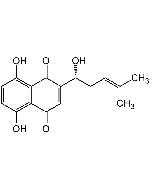Cookie Policy: This site uses cookies to improve your experience. You can find out more about our use of cookies in our Privacy Policy. By continuing to browse this site you agree to our use of cookies.
AdipoGen Life Sciences
Rotenone
As low as
65
CHF
CHF 65.00
In stock
Only %1 left
AG-CN2-0516-G0011 gCHF 65.00
AG-CN2-0516-G0055 gCHF 150.00

| Product Details | |
|---|---|
| Synonyms | Nicouline; NSC 8505; NSC 26258; Tubatoxin |
| Product Type | Chemical |
| Properties | |
| Formula |
C23H22O6 |
| MW | 394.4 |
| CAS | 83-79-4 |
| RTECS | DJ2800000 |
| Source/Host Chemicals | Isolated from Fabaceae species. |
| Purity Chemicals | ≥97% |
| Appearance | White to off-white solid. |
| Solubility | Soluble in DMSO (20mg/ml), ethanol (1mg/ml) or chloroform (20mg/ml). |
| Identity | Determined by 1H-NMR. |
| InChi Key | JUVIOZPCNVVQFO-HBGVWJBISA-N |
| Smiles | CC([C@@]1([H])CC2=C(O[C@]3([H])COC4=CC(OC)=C(OC)C=C4[C@]3([H])C5=O)C5=CC=C2O1)=C |
| Shipping and Handling | |
| Shipping | AMBIENT |
| Short Term Storage | +4°C |
| Long Term Storage | -20°C |
| Handling Advice |
Keep cool and dry. Protect from light. |
| Use/Stability | Stable for at least 2 years after receipt when stored at -20°C. |
| Documents | |
| MSDS |
 Download PDF Download PDF |
| Product Specification Sheet | |
| Datasheet |
 Download PDF Download PDF |
Description
- Cell permeable reversible and competitive mitochondrial electron transport chain complex I (NADH-CoQ reductase) inhibitor (IC50=1.7-2.2μM).
- Inhibits NADH/DB oxidoreductase and NADH oxidase and consequently oxidative phosphorylation (OXPHOS). Specifically inhibits NAD-linked substrate oxidation of NADH dehydrogenase.
- Useful agent for immunometabolism research. Inhibition of electron transport chain in mitochondria leads to blocking of the transfer of electrons from iron-sulfur centers in complex I to ubiquinone. This interferes with NADH during the creation of usable cellular energy (ATP), and Complex I is unable to pass off its electron to CoQ, creating a back-up of electrons within the mitochondrial matrix. Cellular oxygen is reduced to the radical, creating reactive oxygen species, which can damage DNA and other components of the mitochondria.
- Shown to inhibit mammalian cell proliferation, via suppressing microtubule assembly by binding to tubulin and inhibiting autophagy induction, by blocking lysosomal degradation of autophagic vacuoles.
- Shown to induce cell cycle arrest and apoptosis through production of mitochondrial ROS, consequently leading to induction of oxidative stress.
- Used to induce Parkinson's diseases-like syndrome in experimental animal model.
- Selective priming signal for NLRP3 inflammasome activation in combination with ATP, but not with Nigericin or MSU.
- Commonly used as a broad spectrum insecticide, piscicide and pesticide.
Product References
- Rotenone, an anticarcinogen, inhibits cellular proliferation but not peroxisome proliferation in mouse liver: M.L. Cunningham, et al.; Cancer Lett. 95, 93 (1995)
- Rotenone-induced G2/M cell cycle arrest and apoptosis in a human B lymphoma cell line PW: J.S. Armstrong, et al.; BBRC 289, 973 (2001)
- Mitochondrial complex I inhibitor rotenone induces apoptosis through enhancing mitochondrial reactive oxygen species production: N. Li, et al.; J. Biol. Chem. 278, 8516 (2003)
- Rotenone induces cell death in primary dopaminergic culture by increasing ROS production and inhibiting mitochondrial respiration: K. Radad, et al.; Neurochem. Int. 49, 379 (2006)
- Rotenone inhibits mammalian cell proliferation by inhibiting microtubule assembly through tubulin binding: P. Srivastava & D. Panda; FEBS J. 274, 4788 (2007)
- Pesticides and impairment of mitochondrial function in relation with the parkinsonian syndrome: C. Gomez, et al.; Front. Biosci. 12, 1079 (2007)
- Mechanisms of rotenone-induced proteasome inhibition: A.P. Chou, et al.; Neurotoxicol. 31, 367 (2010)
- Rotenone inhibits autophagic flux prior to inducing cell death: B.J. Mader, et al.; ACS Chem. Neurosci. 3, 1063 (2012)
- Mitochondrial complex I inhibitor rotenone-induced toxicity and its potential mechanisms in Parkinson's disease models: N. Xiong, et al.; Crit. Rev. Toxicol. 42, 613 (2012) (Review)
- Rotenone-induced oxidative stress and apoptosis in human liver HepG2 cells: M.A. Siddiqui, et al.; Mol. Cell Biochem. 384, 59 (2013)
- The rotenone model of Parkinson's disease: genes, environment and mitochondria: J.T. Greenamyre, et al.; Parkinsonism Relat. Disord. 9, S59 (2013) (Review)
- Metabolome and proteome profiling of complex I deficiency induced by rotenone: I. Gielisch, & D. Meierhofer ; J. Proteome Res. 14, 224 (2015)
- Rotenone-induced Impairment of Mitochondrial Electron Transport Chain Confers a Selective Priming Signal for NLRP3 Inflammasome Activation: J.H. Won, et al.; J. Biol. Chem. 290, 27425 (2015)
- Succinate Dehydrogenase Supports Metabolic Repurposing of Mitochondria to Drive Inflammatory Macrophages: E.L. Mills, et al.; Cell 167, 457 (2016)
- A guide to immunometabolism for immunologists: L.A. O'Neill, et al.; Nat. Rev. Immunol. 16, 553 (2016)
- The respiratory chain inhibitor rotenone affects peroxisomal dynamics via its microtubule-destabilising activity: J.B. Passmore, et al.; Histochem. Cell Biol. 148, 331 (2017)









